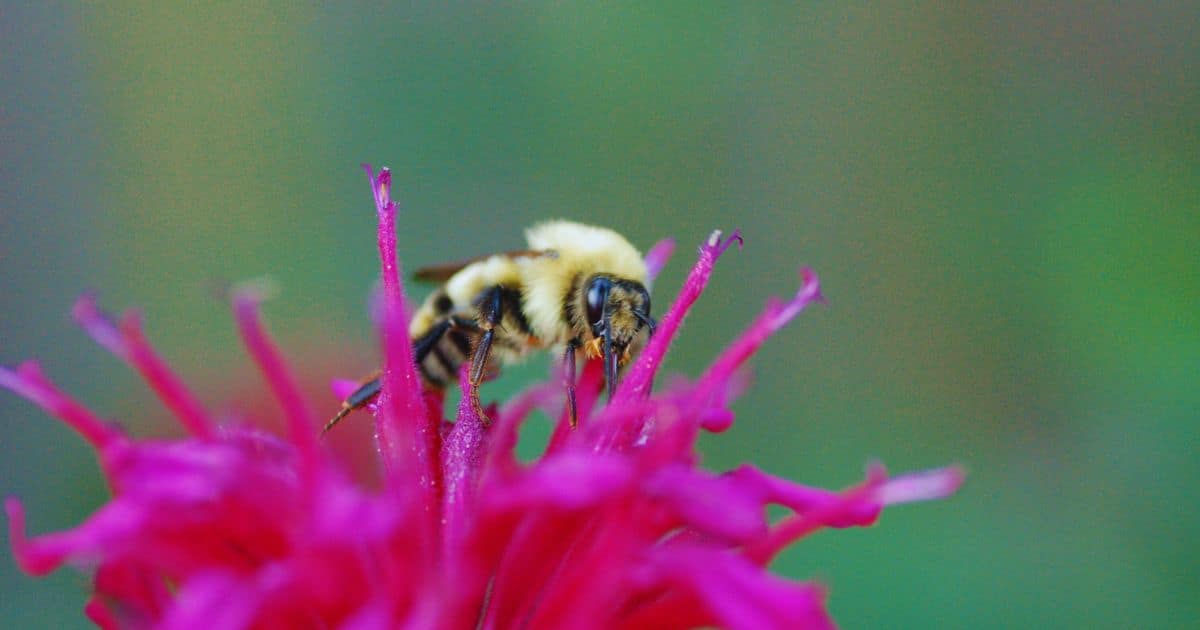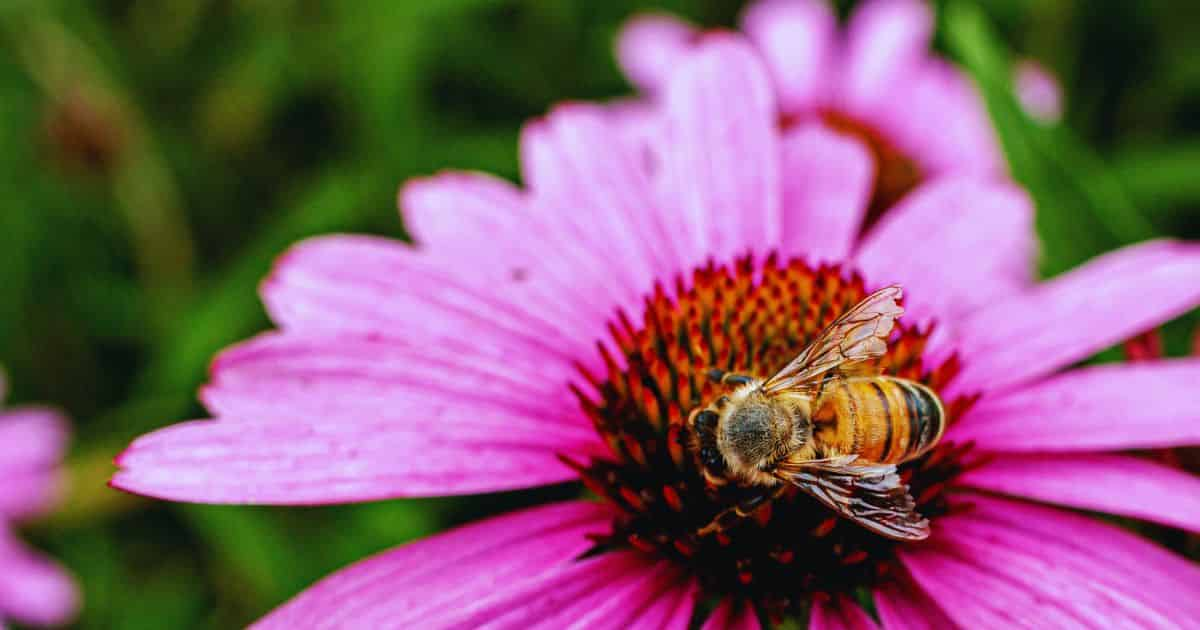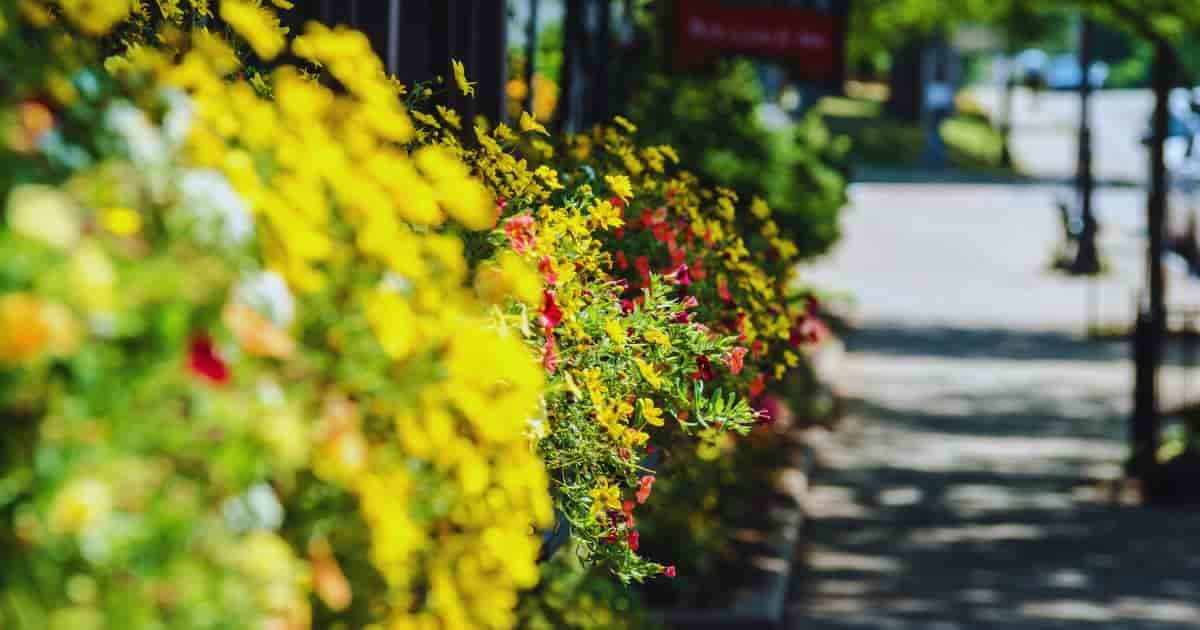Tony O’Neill is the founder of Simplify Beekeeping and an experienced beekeeper with over a decade of hands-on experience. Starting with just a few hives to support his garden, Tony’s passion for beekeeping quickly grew into managing 45 hives. He’s dedicated to making beekeeping accessible and enjoyable for everyone, sharing his knowledge through practical tips, in-depth guides, and engaging videos. When he’s not tending to his bees, Tony enjoys teaching others about the joys of beekeeping, both online and in his local community.
Finding the right plants for urban beekeeping can be tricky. City gardeners face unique challenges, like limited space and picking plants that grow well in small areas. Urban bees often make more honey than country bees because they find more flowers.
This shows how vital a diverse garden is for them.
Our guide lists the best plants and trees that love city life and help bees thrive. From the purple blooms of Echinacea purpurea to the sweet nectar of lavender, we cover what you need for a year-round, bee-friendly garden.
Whether you have a tiny balcony or a small yard, our tips will help you choose right.
Get ready to plant some magic.
Key Takeaways
- Urban beekeeping thrives in small spaces with the right plants, such as lavender, thyme, and goldenrod, which attract bees all year.
- Bee balm, purple coneflower, and black-eyed Susan are great for city gardens. They draw in honeybees and wild bees.
- Local climate matters when picking plants. In North Carolina, native species support over 500 types of bees.
- American basswood and eastern redbud trees work well in urban areas. They offer food to bees even with limited space.
- Joining gardening clubs or online groups can help you learn about urban beekeeping and connect with others who share your interests.
Key Considerations for Urban Beekeeping
When urban beekeeping is done, the available space is crucial. Also, sunlight exposure and the local climate should be considered.
Available space
Urban gardens come in many sizes. They range from extensive gardens to small balconies, window boxes, and lawns. Even if you have just a little space, you can still help bees. You can grow plants that bees love in tiny areas or pots.
Creeping Thyme is a good choice for places with not much room. It grows low to the ground and doesn’t need much space to spread out. This plant is part of the mint family and covers bare spots well.
Plus, it gives bees the food they need.
Even the smallest garden is a big help to a bee.
Next, let’s talk about how sunlight affects your bee garden.

Sunlight exposure
Plants like bee balm and purple coneflower need full sun to part sun. This means they do well in places with lots of sunlight daily. Full sun helps these plants grow, bloom, and make the food bees come for.
If you’re growing these in a city garden, find sunny spots most of the day.
Not all spaces in a city get good sunlight. Some areas might be too shady because of tall buildings or trees. If your garden is like this, it’s harder to grow plants that bees like, such as bee balm or purple coneflower.
You might need to pick different plants that can grow with less light or use containers to move your plants into sunny spots throughout the day.
Local climate
Local climate affects how well plants grow in your area. North Carolina is home to over 500 species of native bees. This makes the state perfect for planting flowers that help bees.
According to USDA maps, plants that fit into hardiness zones three and above do well here. These zones tell you which plants will most likely thrive in local weather conditions.
Choosing the right plants for your bee garden depends on understanding these zones. For example, bee balm and purple coneflower love the climate in North Carolina. They attract many native bees and other pollinators, such as butterflies and hummingbirds.
Knowing your local climate helps you pick the best plants that bloom nicely and support local wildlife, making your urban beekeeping successful.

Top Plants for Urban Bee Gardens
In an urban setting, bee balm (Monarda spp.), purple coneflower (Echinacea purpurea), and black-eyed Susan (Rudbeckia hirta) are excellent choices for attracting bees.
These plants grow well in small spaces and provide a good source of nectar and pollen for urban honeybees, bumblebees, and other wild bees.
Bee balm (Monarda spp.)
Bee balm, or Monarda spp., is a favorite among honeybees and wild bees. This plant thrives in small gardens and attracts pollinators with its vibrant flowers. Bee balm belongs to the mint family and shows off intense red, pink, or purple colors.
Gardeners love it for both its look and its ability to bring bees into their spaces.
This perennial blooms in spring, fitting well into an urban bee garden’s seasonal planning. A pack of 85 seeds costs just $6.99 on Amazon. Beyond attracting bees, bee balm also invites butterflies and hummingbirds, making any garden a hub of activity.
Planting bee balm supports a rich ecosystem right in your own backyard.
Easy to grow in pots or direct soil, bee balm adapts well to various conditions, although it prefers sunny spots. By choosing bee balm for your garden, you provide essential resources for pollinators while enjoying the beauty these plants add to your space.

Purple coneflower (Echinacea purpurea)
Purple coneflower, or Echinacea purpurea, thrives from late spring to summer. You can buy a pack of 100 seeds for $5.95 on Amazon. This plant is a perennial, meaning it comes back every year.
It’s great for bees and other pollinating insects like butterflies and moths.
It grows well in small spaces and adds beauty with its bright flowers. Bees love the nectar and pollen from these flowers. Planting purple coneflower helps create a friendly space for bees in urban gardens.

Black-eyed susan (Rudbeckia hirta)
After looking at the purple coneflower, we turn to another bright spot in the bee garden: the Black-eyed Susan. This plant is an annual that shines in summer. A pack of 100 seeds costs $5.99 on Amazon, making it both easy and cheap to add to your space.
Black-eyed Susans are part of the sunflower family. They have golden petals that circle a dark center. Bees, including honey bees and solitary bees, love these flowers. Planting them helps create a happy place for bees in your urban garden.
They also make your garden look bright all through summer.

Best Shrubs and Trees for Bees in Urban Settings
The best shrubs and trees for bees in urban settings are essential. These provide valuable food and habitat for bees in a limited space. Check out our blog to learn more about the most suitable plants for urban beekeeping!
American basswood (Tilia americana)
American basswood is an excellent tree for bees in cities. Dwarf types can grow in pots. This tree provides nectar and pollen to honeybees, bumblebees, and other insects. It stays pretty into late summer.
So, it feeds pollinators for a long time.
You can grow American basswood from seeds. This makes it easy for city beekeepers to use it. The tree fits many garden designs well. It helps bees a lot in cities.
Next, let’s talk about Eastern redbud (Cercis canadensis).
Eastern redbud (Cercis canadensis)
The eastern redbud (Cercis canadensis) is a tree full of nectar. Bees love it for its sweet food. You can grow this tree from seeds, which is good news for city gardeners with little space.
It fits well in small areas and helps bees find the food they need.
This tree blooms at a time that fills gaps in city gardens’ bloom schedules. That means bees have a constant source of nectar and pollen. Gardeners like to plant eastern redbuds because they attract many kinds of bees to their gardens.
Eastern redbud plays a key role in keeping urban bees healthy by offering diverse feeding options.
Container-Friendly Bee Plants
Container-friendly bee plants, like lavender and thyme, are perfect for small spaces. Read more to find out about other plants suitable for urban beekeeping.
Lavender (Lavandula spp.)
Lavender blooms all summer, helping bees stay busy in your garden. It loves pots, making it perfect for small spaces like balconies or patios. Bees love the flowers, and you’ll enjoy the lovely scent.
You can grow lavender quickly. It does not have much water and loves sunlight. Plus, putting lavender in containers means you can move them to catch the sun or keep away from pests. Your gardening skills will shine with lavender, and bees will thank you by visiting often.

Thyme (Thymus vulgaris)
Thyme (Thymus vulgaris), also known as creeping thyme, blossoms in the summer, which attracts honeybees. It’s not just lovely to look at; it’s also a valuable kitchen herb. Harvesting its leaves promotes growth and health for honeybees in urban settings.
Thyme (Thymus vulgaris) blooms in summer and is beneficial for honeybees.
Seasonal Planting Strategy for Continuous Blooms
Plan your planting for continuous blooms throughout the year with spring bulbs like crocus and hyacinth, followed by lavender and thyme for summer and goldenrod for autumn. Read more about creating a bee-friendly garden in small spaces!
Spring: Crocus and hyacinth
Crocuses and hyacinths can be planted in the fall. They bloom beautifully in the spring. Iris reticulata is great for cooler climates during this time.
Incorporating crocuses and hyacinths into your garden will bring vibrant colors to your surroundings while providing essential nourishment for bees. Consider adding these bulbs to ensure a rich environment for pollinators and yourself, all while celebrating the arrival of spring.
Moving on to our next point – Summer: Lavender and thyme…
Summer: Lavender and thyme
Summer brings an abundance of blooms from lavender (Lavandula spp.) and creeping thyme (Thymus serpyllum), which are essential additions to bee gardens. Lavender, with its aromatic purple florets, provides a rich and continuous source of nectar for bees throughout summer.
Conversely, creeping thyme offers clusters of tiny flowers that attract pollinators such as bumblebees and hoverflies. Their consistent blooming during this season supports the sustenance of bee colonies within urban environments, contributing to the survival of these vital pollinators.
These two plants enrich urban green spaces and play a crucial role in supporting local ecosystems by providing food sources for bees and other native pollinators. Lavender and thyme are valuable assets to any urban beekeeper’s garden, adding beauty to city landscapes while aiding in biodiversity preservation.
Autumn: Goldenrod (Solidago spp.)
Transitioning from summer to autumn, Goldenrod, known scientifically as Solidago spp., blooms in late summer and fall. As a perennial plant, it provides a vital food source for bees during this time.
Wrinkleleaf Goldenrod (Solidago rugosa) is particularly significant during these months, contributing to the ongoing support of bee populations in urban settings. Its vibrant yellow flowers attract pollinators, including bumblebees and honeybees, promoting biodiversity in local environments.
The presence of Goldenrod enhances the ecological balance within urban bee gardens by providing sustenance when other flowering plants are less abundant. It thrives well in diverse climates and is suitable for small spaces or container gardening where traditional gardens may not be feasible.
When strategically incorporated into seasonal planting plans, Goldenrod ensures continuous blossoms throughout autumn, facilitating a sustainable bee environment even as temperatures cool.

Resources for Urban Beekeepers
Urban beekeepers can benefit from joining local gardening clubs to gain valuable insights and connect with like-minded individuals. Online forums and workshops are also excellent resources for learning about urban beekeeping best practices and getting support from the community.
Local gardening clubs
Local gardening clubs offer vital resources and support for urban beekeepers in small areas. They guide selecting bee-friendly plants that thrive in urban environments, identifying flowering plants that bloom throughout different seasons, and ensuring a consistent food source for bees.
Moreover, these clubs emphasize cultivating native plants, which require less maintenance and support local pollinator populations. They also educate gardeners on refraining from pesticide use and creating habitats beneficial to all pollinators.
These clubs are crucial in promoting sustainable practices while nurturing a community of urban beekeepers.
Moving forward with the blog outline, let’s explore essential considerations for urban beekeeping.
Online forums and workshops
Online forums and workshops offer essential guidance for urban beekeeping. These platforms specifically focus on the best plants for urban bee gardens, providing resources and firsthand experiences from community engagement to raise awareness about the significance of urban parks for pollinators.
They cover plant care, maintenance, and garden design, as well as tips on selecting the right plants to grow in small spaces. Participants can also share their experiences and tips on urban gardening and beekeeping.
Moreover, these sessions also help by addressing challenges and tailoring information towards plant varieties that thrive in such settings.
Furthermore, these online platforms provide valuable information, including statistics about pollinator gardens’ uptake among communities. The conversations are enriched by the wealth of experience shared by individuals who have embraced habitat gardening promotion around neighborhoods.
Such forums allow participants to exchange tangible insights into nurturing effective apiaries within limited spaces, ensuring ongoing support within this ever-evolving realm.
Conclusion
In conclusion, urban beekeeping can flourish with various plants in small spaces, supporting honeybees and native pollinators. By creating gardens rich in wildflowers and incorporating seasonal blooms like lavender and thyme, beekeepers can ensure continuous support for bees throughout the year.
It’s essential to concentrate on native North Carolina plants to simplify maintenance and promote bee health. Remember to select single-blooming flowers for maximum pollen production, considering your experience planting bee-friendly species.
Participating in local gardening clubs or online forums is valuable for gaining further insights into urban beekeeping.

FAQs
1. What are some excellent plants for urban beekeeping in small spaces?
Great choices include bergamot, allium schoenoprasum (chives), Helleborus (hellebores), Liatris spicata, cynara scolymus (cardoons or globe artichokes), and symphyotrichum novae-angliae (New England aster).
2. How can I attract more bees to my city garden?
Plant a variety of perennials, such as white clover, wallflowers, milkweed and asters. Consider adding butterfly weed for monarchs and honeysuckles to attract bumblebees.
3. Are there any considerations when choosing plants for an urban apiary?
Yes! Avoid invasive species and be mindful of wind-pollinated plants that may not need bees. Also, avoid using pesticides, especially neonicotinoids, which harm bees.
4. Can I grow these plants in community gardens or front yard spaces?
Absolutely! Many of these plants, including calendula officinalias (pot marigold) and baptisia alba (white wild indigo), work well in cottage gardens, habitat gardens or even as part of your front yard turf.
5. Do certain insects prefer specific types of flowers?
Indeed they do! For instance, the black swallowtail butterfly enjoys Umbelliferae family members like parsley, while mason bees will appreciate roses.
6. Where can I buy these bee-friendly plants?
Check out local nurseries, where you should find a wide range of plants, from perennials to annuals like sweet alyssum or California poppy.





Leave a Reply